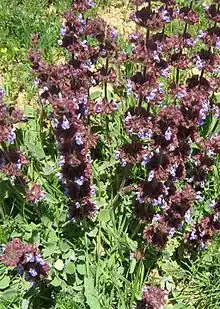| Salvia multicaulis | |
|---|---|
 | |
| Salvia multicaulis growing in its natural habitat in Tannourine cedar reserve, Lebanon | |
| Scientific classification | |
| Kingdom: | Plantae |
| Clade: | Tracheophytes |
| Clade: | Angiosperms |
| Clade: | Eudicots |
| Clade: | Asterids |
| Order: | Lamiales |
| Family: | Lamiaceae |
| Genus: | Salvia |
| Species: | S. multicaulis |
| Binomial name | |
| Salvia multicaulis | |
| Synonyms | |
|
S. acetabulosa | |
Salvia multicaulis is a low-growing perennial shrub native to Turkey and bordering countries. Plants grow into mats up to 90 cm (3.0 ft) wide, with erect woody stems. The plant reaches 15 cm (5.9 in) tall, though the flowering stems reach 30 to 45 cm (12 to 18 in). The oval leaves are grey-green, 3 cm (1.2 in) long by 2 cm (0.79 in) wide, with a rugose upper surface and whitish hairy underside.
Small violet flowers grow in whorls of 4–10 with conspicuous reddish-brown bracts.[1] It has been reported that the plant has significant antioxidant and antimicrobial activity. [1]
Notes
- 1 2 Pehlivan, Mustafa; Sevindik, Mustafa (2018-04-29). "Antioxidant and Antimicrobial Activities of Salvia multicaulis". Turkish Journal of Agriculture - Food Science and Technology. 6 (5): 628–631. doi:10.24925/turjaf.v6i5.628-631.1906. ISSN 2148-127X.
External links
This article is issued from Wikipedia. The text is licensed under Creative Commons - Attribution - Sharealike. Additional terms may apply for the media files.